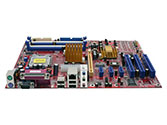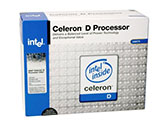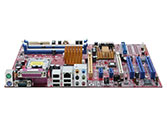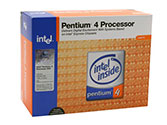Entry Level Buyer’s Guide, July 2005
by Jarred Walton on July 20, 2005 12:05 AM EST- Posted in
- Guides
Intel Recommendations
Not a whole lot has changed in the budget Intel market. Intel has had PCIe graphics for a while now, and we're still waiting for newer Celeron and Pentium chips with 64-bit support. (We're also waiting for Semprons with 64-bit support, though really we're not too concerned about the 64-bit factor for budget systems.)  |
 |
| Click images to enlarge. | |
Budget 775 Motherboard: Biostar I915P-A7
Price: $79 shipped
Budget 775 CPU: Intel Celeron D 330J 2.66GHz 256K L2 (Retail)
Price: $85 shipped (Retail)
Total: $164
Almost exactly matching the budget AMD setup in price, we continue with similar recommendations to our last budget Guide. The choice of CPU is less about performance than price, but the difference between the 2.53 GHz 325 and the 2.66 GHz 330J is only $4, so we go with the upgraded processor. You can see the complete list of Celeron prices on our Price Engine, and the next model up from the 330J adds $15, which is more than we're willing to pay for a budget setup.
The motherboard choice is the cheapest 775 motherboard that we could find with a few qualifications. First, it needs to be a PCI Express board, which generally means the 915P or 915G chipset. We avoid the 915GV chipset as that reduces performance by only supporting single-channel memory. The other requirement is that the board needs to have 4 DIMM slots of the same type, and for now, that means DDR. Some people may not mind the hybrid boards, but we like to have the ability to run 4x512MB of RAM in the future. The Biostar I915P-A7 fits all of those requirements and comes in substantially cheaper than most other competitors. Biostar also offers the I915G-M7 for those who want integrated graphics - as a business solution or a standby until you can add in a decent graphics card, the extra $6 is a good deal.
The only other boards that are priced similarly are from Jetway (915PCP/GCP), ECS (915G-M), Foxconn (915G7MC-S), and Aopen (i915Pa-E) - we may have missed one or two boards, but the point is that there aren't any name brands like ASUS or MSI in this price range. None of these are really better than the Biostar in our opinion, and they all cost a bit more.
If you like the idea of integrated graphics but want more performance, the ASUS P5RD1-V uses the ATI Xpress 200 chipset and may be worth consideration. The price of $100 makes it a moderately expensive upgrade, and if you're looking at an IGP solution you probably don't care much that the Xpress 200 is twice as fast in several gaming benchmarks - a discrete graphics card will still outperform the IGP with relative ease. As with the MSI Xpress 200 board for AMD, we don't expect much in the way of overclocking due to the chipset. Overclockers should probably look to the more recognized enthusiast brands like ASUS, DFI, MSI, etc. and get an Intel chipset, though you'll also have to pay over $100 for those.
 |
 |
| Click images to enlarge. | |
Upgraded 775 Motherboard: Biostar I945P-A7
Price: $98 shipped
Upgraded 775 CPU: Intel Pentium 505 533 FSB (Retail)
Price: $134 shipped (Retail)
Total: $232
Our upgraded Intel platform takes a bit different approach than the past. Price is once again equal to the AMD side of things, but we spend more on the motherboard and less on the CPU. We cut the CPU from the Pentium 520 of previous Guides (2.8 GHz 800FSB with HyperThreading) to the 505 (2.66 GHz 533FSB and no HyperThreading). HTT is sort of interesting, but the extra $40 to upgrade to the 520 is pretty significant. Actually, the 530J is only a couple of dollars more than the 520, so if you do go for the faster processor, the 530J is the better buy. Performance of the 505 is reasonable, though clearly outclassed by the Athlon 64 processors. Part of the reason why we like the 505 is that you can get some great overclocking results from it on virtually any motherboard. The processor has a 20X multiplier, so combined with a bus speed of 166 to 200, you can shoot for 3.33 GHz to 4.0 GHz. The upper end of that range may be difficult to reach, but 3.4 to 3.6 GHz is pretty reasonable for the 90nm Prescott design.
Along with the switch to a slightly slower CPU, we've included the cheapest DDR2 board that we could find for future compatibility, and it also uses the new 945P chipset. The switch to DDR2 will increase the price slightly relative to DDR, but even AMD will be moving to DDR2 early next year, so you should be able to use the RAM in a future system. Integrated graphics versions of the chipset are also available with the 945G series, with the most affordable options coming from ASUS (P5LD2-VM) and Intel themselves. The cheapest 945G models are micro ATX form factors, allowing the use of a smaller case like the Aspire X- QPack that we recently reviewed, as well as any other uATX case. (You can always put the small motherboard in a full-size ATX case if you prefer.)
The 945 chipsets all support dual core CPUs, providing another future upgrade path. With the cheapest Pentium D starting at well over $200, we can't recommend such a CPU for a budget system yet, but we expect prices to drop over the coming year, making it a viable upgrade in 2006. If you go with the budget Intel recommendation, you're stuck with single core processor support for as long as you own the system. Of course, some people never upgrade individual components and prefer to replace the entire system every few years. If that describes your purchasing habits, there's not much point in buying more future-proof components.










57 Comments
View All Comments
OldPueblo - Thursday, July 21, 2005 - link
Doh. Anyway, the Asus website has the specs listed and they do say 700Mhz. Is the website wrong then? http://usa.asus.com/prog/spec.asp?m=Extreme%20N620...Graphics Engine NVIDIA GeForce 6200 w/TurboCache
Video Memory 64MB/64bit DDR onboard
Effective Memory Size 256MB
Effective Memory Bandwidth 128bit
Engine Clock 350MHz
Memory Clock 700MHz(350MHz DDR)
RAMDAC 400MHz
Bus Standard PCI Express 16X
Max Resolution 2048x1536
VGA Output Standard 15-pin D-sub
Vedio Output Composite
DVI Output DVI-D (Available only in TD model)
2nd VGA Output N/A
Adaptor/Cable bundled N/A
OldPueblo - Thursday, July 21, 2005 - link
Calin - Thursday, July 21, 2005 - link
JarredWalton, I would buy a 17" LCD - however, I think the resolution is just too small. So I will have to wait for a 19" LCD that has the same resolution, but the text has a readable size, in order not to experience all those artifacts generated by non-native resolution.Zebo - Thursday, July 21, 2005 - link
I still say a sub $75 TC videocards like you recommned is worthless for gaming, even at low res 1024x768 featured on 15" LCDs it studders.. Need 600/700pro or 6200/6600 minimum. Again what's wrong with $50 mobos with inegrated graphics for a budget setup? Millions of Americans who shop at Dell get integrated graphics every year and could care less. But I do bet they opt for 17" or even 19" LCD's with thier package.BPB - Thursday, July 21, 2005 - link
Geez, how'd I miss that? I was specifically looking for the RS480M2-IL too. Sorry.BPB - Thursday, July 21, 2005 - link
Geez, how'd I miss that? I was specifically looking for that too.kmmatney - Thursday, July 21, 2005 - link
They really need some Semprons for S939 - the MSI RS480M2-IL is not very compelling for a budget system without Semprons.JarredWalton - Wednesday, July 20, 2005 - link
14/38: the MSI board is mentioned as an integrated graphics alternative. No OC'ing features at all, so not everyone will like it, but I did mention that the cost of a discrete graphics card basically makes the MSI+939 the same price as the budget mobo+CPU+GPU and you get a faster CPU. (See page 2, last paragraph.)BPB - Wednesday, July 20, 2005 - link
#14, I agree with you. Got the MSI RS480M2-IL and built a very nice system for my daughter. With the saving on video card got a better CPU. When she needs it I'll get her a better video card. I started out with the same hard drive as the article and then added another, bigger drive. For a monitor she has the Samsung 17" 730B purchased at Staples, on sale for about $200. Very happy with everything. Also, the MSI board supports the X2 CPUs so it has great upgrading potential should I decide to use it for my video editing system and build something else for her.JarredWalton - Wednesday, July 20, 2005 - link
Due to an error in specifications, we have changed the budget GPU recommendation to an X300SE - the cheapest PCIe card with DVI that we could find. It turns out that the ASUS does *not* have 700MHz RAM - in fact, we couldn't find any 64-bit 6200TC cards with 700MHz RAM. The price of the better TurboCache models is getting dangerously close to that of faster models, so we decided to simply cut the price $20 and go with a cheaper card. The graphics page and summaries have been updated accordingly. If you can find a card that offers substantially better performance in the $50 to $65 range, send me an email.(Grumble: The overlapping specs on the low-end graphics cards is a nightmare of confusion. /Grumble)